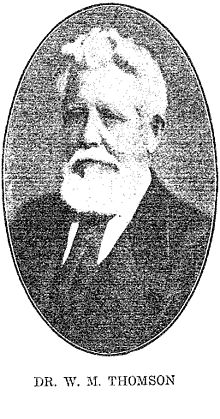

William Thomson
| |
|---|---|

Portrait of Dr. W. M. Thomson
| |
| Born | William McClure Thomson (1806-12-31)December 31, 1806 |
| Died | (1894-04-08)April 8, 1894 |
| Nationality | American |
| Other names | أبو طنجرة (Abu Tanjera) |
| Alma mater | |
| Occupation | Missionary |
| Known for | Establishing the American University of Beirut (formerly the Syrian Protestant College) |
William McClure Thomson (31 December 1806, in Springdale, Ohio – 8 April 1894, in Denver, Colorado) was an American Protestant missionary who worked in Ottoman Syria. After spending 25 years in Syria, he published a bestselling book that described his experiences and observations during his travels. He used his knowledge of the region to illustrate and explain passages from the Bible, giving readers a new perspective on the scriptures.[1][2][3]
Thomson was the son of a Presbyterian minister. He was a graduate of Miami University, Ohio.
When he arrived in Beirut on February 24, 1833, he was only the eighth American Protestant missionary to arrive in the region. Two of his predecessors had died and two had been recalled. In April 1834, Thomson was in Jaffa when a Peasants' Revolt broke out, and he was unable to return to Jerusalem until Ibrahim Pasha recaptured the city with 12,000 troops. Sadly, while he was away, his wife had given birth to a son, but she died just 12 days after he returned.[4][5]
After his wife's death, Thomson relocated to Beirut with his young son. There, in 1835, with Rev. Story Hebard, he established a boarding school for boys. In August 1840, Thomson and other American missionaries were evacuated from Beirut by the USS Cyane, and witnessed the bombardment of the city by a coalition of British, Austrian, and Turkish naval forces under the command of Charles Napier. The bombardment, which lasted for one month, forced Ibrahim Pasha's army to retreat. Meanwhile, a conflict broke out between the Druze and Maronite communities in Lebanon. In 1843, Thomson and Cornelius Van Alen Van Dyck founded a boys seminary in Abeih, Lebanon. Two years later, in 1845, a new outbreak of violence occurred, and Thomson once again played a role in negotiating a truce. He remained in Sidon until 1857, when he returned to America for two years.
In 1860 full scale civil war broke out in Lebanon. The conflict lasted sixty days and spread to Damascus. Thomson supervised the distribution of £30,000 of money, food and clothing amongst the thousands of destitute refugees.
At a Beirut Mission Meeting on 23 January 1862, he proposed the establishment of a college with Daniel Bliss as its President. The Syrian Protestant College was established in 1866 with 16 students. This college was to evolve into the American University of Beirut.[4]
Theophilus Waldmeier's autobiography states that it was on Thomson's advice, in 1873, that Waldmeier established Brummana High School.[5]
His local nickname became Abu Tangera—father of the cooking pot—after his broad-rimmed hat. With his local knowledge, he was used as a dragoman by several Biblical scholars. In 1852, he accompanied one of the founders of modern Biblical archeology, Edward Robinson on his second tour of the Holy Land.[6]
[7]

In 1859, Thomson published a book entitled "The Land and the Book," which described his experiences in the Middle East. The book was aimed at a general audience rather than an academic or theological one, and it quickly became very popular. In the United States, it was only outsold by "Uncle Tom's Cabin," an abolitionist novel by Harriet Beecher Stowe, over the following forty years.[8]
The book is framed around a pilgrimage undertaken during 1857. Thomson is accompanied by an unnamed individual whose questions enable the author to recount his experiences and illustrate stories from the Bible. They set out from Beirut in January, riding South to Sidon and Tyre, from where they cut inland and arrived in Palestine via the Hula Valley. They visited Safad, Tiberias, Nazareth and Jenin before returning to the coast at Caesarea and South to Jaffa, Ashdod and Gaza. From Gaza, they turned North via Bayt Jibrin, Hebron and Bethlehem, ending the journey in Jerusalem.
In his book he gives lengthy accounts of two memorable events. He was one of the first outsiders to arrive at Safad following the devastating 1837 earthquake, and in June 1839, he presided over the funeral of Lady Hester Stanhope.
The naturalist Henry Baker Tristram, author of A Natural History of the Bible, used Thomson's book as his guide during his own exploration of Palestine.
At the turn of the century, an English writer, H. Rider Haggard, covered a similar itinerary. When he landed at Haifa, his party had difficulty hiring horses due to a nationwide shortage caused by the arrival of a party of 500 Americans on a tour of the Holy Land.[8]
Many of the illustrations in the book are by his son, William Hanna Thomson.[9]

|
Protestant missions to the Middle East
| ||
|---|---|---|
| Background |
| |
| People, country of origin |
| |
| Missionary agencies |
| |
| International |
|
|---|---|
| National |
|
| Academics |
|
| Other |
|